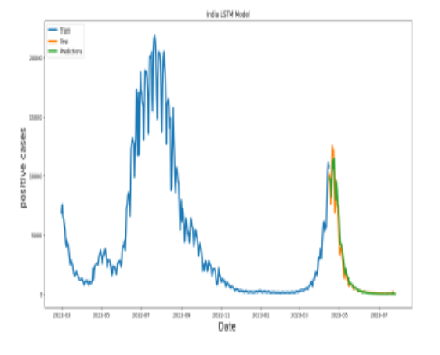


Indian Journal of Science and Technology
Year: 2024, Volume: 17, Issue: 23, Pages: 2421-2429
Original Article
M Rajendar1,2∗, D Mallikarjuna Reddy3, V Nagaraju4
1Research Scholar, Department of Mathematics, School of Science GITAM: Deemed to be University, Hyderabad, 502329, Telangana, India
2Assistant professor, Department of Mathematics, CMR Technical Campus, Hyderabad, 501401, Telangana, India
3Department of Mathematics, School of Science GITAM: Deemed to be University, Hyderabad, 502329, Telangana, India
4Assistant Professor, Department of Mathematics, Nalla Malla Reddy Engineering College, Hyderabad, 500088, Telangana, India
*Corresponding Author
Email: [email protected]
Received Date:27 March 2024, Accepted Date:11 April 2024, Published Date:04 June 2024
Objective: This study focuses on evaluating the accuracy of models that can be identified by taking the data of COVID-19-positive cases in India. Methods: To build the models by using the procedures, Artificial Neural Networks (ANN) and Auto Regressive Integrated Moving Average (ARIMA). The data has been taken for various time periods of (Covid-19 positive cases) from March 2022 to July 2023; March 2022 to Nov. 2022 and from Nov. 2022 to July 2023. The data was collected from the official website of the World Health Organization (WHO). The traditional ARIMA and Long Short-Term Memory (LSTM) deep learning methods were applied to build models for various time periods. Findings: Model performance is being measured with the error parameter (Root Mean Square Error) RMSE (215.74, 100.36 and 127.81) respectively for all the time periods. LSTM is performing better than the ARIMA with a minimum value of RMSE. Novelty: The study has been done for the time periods of Covid-19 positive cases with the help of LSTM, Bi-LSTM and ARIMA methods. The outcome of these methods gave; LSTM is the accurate and best performance model.
Keywords: ARIMA, Neural Networks, LSTM, RMSE
© 2024 Rajendar et al. This is an open-access article distributed under the terms of the Creative Commons Attribution License, which permits unrestricted use, distribution, and reproduction in any medium, provided the original author and source are credited. Published By Indian Society for Education and Environment (iSee)
Subscribe now for latest articles and news.